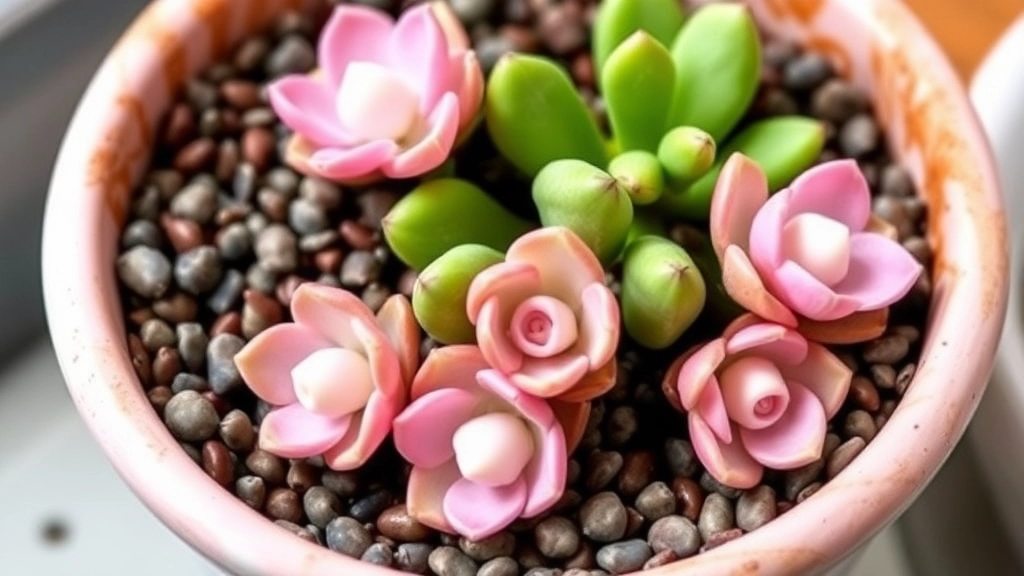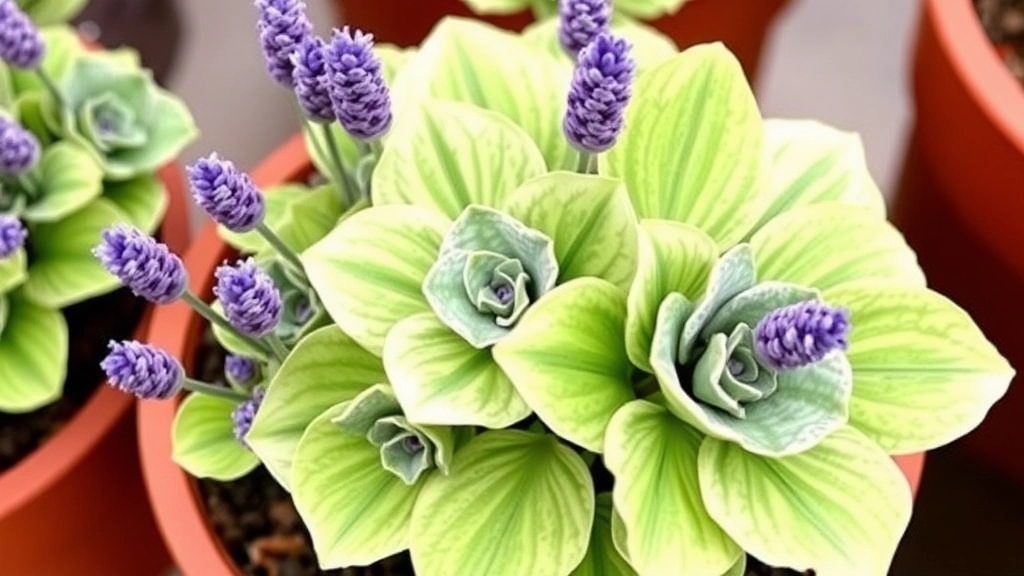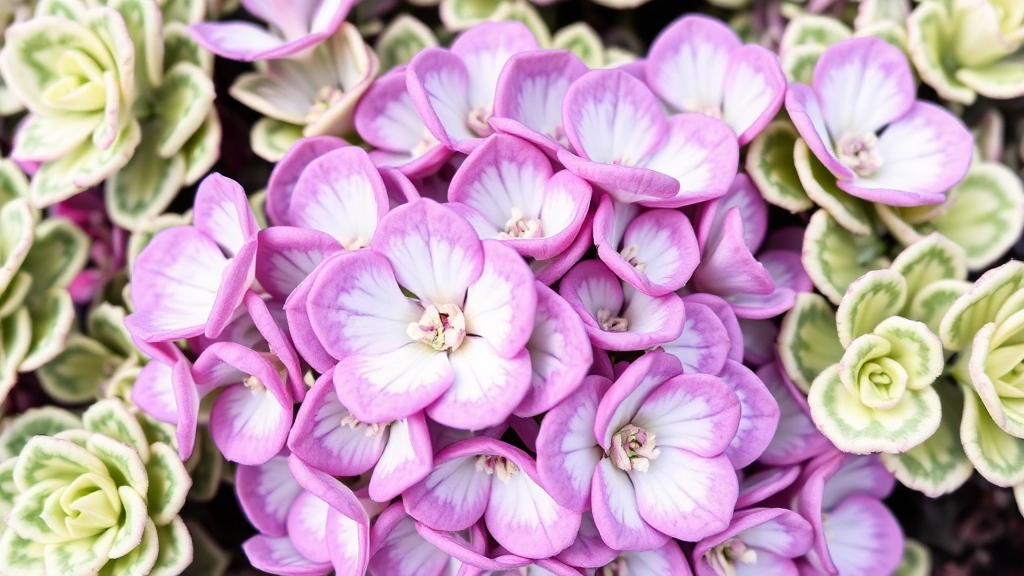Mastering the Care of Kalanchoe Lavender Scallops Variegated
Looking to master the care of Kalanchoe Lavender Scallops Variegated? You’re in the right place. This unique succulent, known for its striking foliage, thrives with the right light, water, and soil conditions. Let’s dive into the essentials to keep your plant healthy and vibrant.
Light Conditions
First off, ensuring the best light conditions is crucial. Kalanchoe Lavender Scallops Variegated loves bright, indirect sunlight. Too much direct sun can scorch the leaves, while too little light can cause them to lose their beautiful variegation. Find a balance to keep your succulent happy and colourful.
Best Light Conditions for Variegated Lavender Scallops
When it comes to caring for variegated lavender scallops, one of the most pressing concerns is their light requirements.
These stunning plants thrive in bright, indirect sunlight.
- Ideal Light Exposure: Place your variegated lavender scallops near a window that receives filtered light. South or east-facing windows are often the best choice.
- Avoid Direct Sunlight: While they enjoy brightness, direct sun can scorch their delicate leaves. If you notice browning or fading, it may be a sign of too much sun.
- Adjusting to Low Light: If your plant is in a low-light environment, it may become leggy and lose its vibrant colours. Consider rotating it to a brighter spot if you notice these changes.
- Seasonal Changes: During winter months, when daylight is shorter, you might want to move your plant closer to the light source to maintain its health. For more detailed guidance, you can refer to this lighting and care tips for similar succulents.
Understanding the seasonal changes and adjusting accordingly can help keep your variegated lavender scallops healthy. If you’re interested in learning more about the best care practices for other types of Kalanchoe, check out this care guide for Kalanchoe flapjacks.
Watering Needs and Soil Requirements

So, you’ve got your stunning variegated lavender scallops and you’re wondering how to keep them thriving.
Watering Needs
First off, let’s chat about watering.
- Frequency: Lavender scallops prefer their soil to dry out between waterings.
- Signs: If the leaves start to wrinkle or look a bit droopy, it’s time to give them a drink.
- Method: Water deeply, but make sure the pot has drainage holes. You want to avoid soggy roots, which can lead to rot.
Soil Requirements
Now, onto soil.
- Type: A well-draining mix is key. Think cactus or succulent soil.
- pH Level: Aim for a slightly acidic to neutral pH (around 6.0 to 7.0).
- Additives: You can mix in perlite or sand to improve drainage.
Let’s keep those roots happy and healthy!
Fertilization and Seasonal Growth Tips for Variegated Lavender Scallops
When it comes to nurturing your variegated lavender scallops, understanding their fertilization and growth patterns is essential. You might be wondering, “How can I ensure my Kalanchoe thrives throughout the seasons?” Here’s a straightforward guide to help you along the way.
Propagating Kalanchoe Lavender Scallops at Home

Are you eager to expand your collection of Kalanchoe Lavender Scallops? This delightful succulent is not only visually stunning but also easy to propagate at home.
Propagation Methods
- Leaf Cuttings
- Select a healthy leaf from an established plant.
- Cut the leaf at the base using a clean, sharp knife.
- Allow the cut end to callous over for a few hours or overnight.
- Place the leaf on well-draining soil, ensuring the cut end is in contact with the soil.
- Water sparingly until roots develop.
- Offsets
- Look for small offsets or “pups” at the base of the parent plant.
- Gently twist or cut the pup away from the main plant.
- Allow it to dry for a day before planting in its own pot with suitable soil.
- Water lightly to encourage root growth.
- Stem Cuttings
- Choose a healthy stem and cut it just below a leaf node.
- Let the cutting dry for a few hours to form a callous.
- Plant in well-draining soil and water lightly.
Tips for Successful Propagation
- Timing: The best time for propagation is during the growing season, typically spring and summer.
- Environment: Ensure the cuttings are in a warm, bright location but out of direct sunlight to avoid scorching.
- Patience: Rooting can take anywhere from a few weeks to a couple of months, so patience is key.
By following these straightforward methods, you can successfully propagate Kalanchoe Lavender Scallops and enjoy the satisfaction of nurturing new plants.
Dealing with Pests and Common Diseases
As we continue to nurture our variegated lavender scallops, it’s essential to be vigilant about pests and diseases that could compromise their health.
Ideal Potting and Repotting Practices for Variegated Lavender Scallops

So, you’ve got your stunning Variegated Lavender Scallops, and now you’re wondering about the best way to pot and repot them, right?
Choosing the Right Pot
- Size Matters: Start with a pot that’s about 2 inches larger in diameter than the current one. This gives the roots space to grow without drowning in excess soil.
- Drainage is Key: Ensure your pot has drainage holes. Standing water can lead to root rot, which is a nightmare for your plant.
Soil Selection
- Well-Draining Mix: Use a cactus or succulent potting mix. You want a blend that allows water to flow through easily.
- Add Some Grit: Mixing in perlite or sand can improve drainage even further. It keeps the roots happy and healthy!
When to Repot
- Signs to Watch For: If you notice roots poking out of the drainage holes or the growth has slowed, it’s time to repot.
- Seasonal Timing: The best time to repot is during the spring or early summer when the plant is actively growing.
Repotting Steps
- Prep Your Space: Lay down some newspaper or a mat to catch any mess.
- Gently Remove the Plant: Carefully take the plant out of its pot. If it’s stuck, wiggle it gently.
- Inspect the Roots: Trim any brown or mushy roots. Healthy roots should be white or light tan.
- Add Fresh Soil: Place some fresh soil at the bottom of the new pot. Position your plant and fill in around it with more soil, leaving about an inch of space at the top.
- Water Lightly: After repotting, give it a light watering to settle the soil, but don’t soak it.
Aftercare
- Avoid Direct Sunlight: After repotting, keep your plant out of direct sun for a week to help it adjust.
- Monitor Watering: Be cautious with watering for the first few weeks. The roots need time to recover.
Potting and repotting your Variegated Lavender Scallops doesn’t have to be daunting. Just follow these easy steps, and your plant will thrive!
Toxicity Concerns for Pets and Humans
As we explore the care of Variegated Lavender Scallops, it’s essential to address a crucial concern: toxicity.
Many plant enthusiasts wonder, “Are Kalanchoe Lavender Scallops safe for my pets and family?”
The answer is nuanced, so let’s break it down:
- Toxicity Level: Kalanchoe species, including the Lavender Scallops, are known to be toxic if ingested.
- Symptoms of Ingestion:
- Vomiting
- Diarrhoea
- Lethargy
- Drooling
If you suspect your pet has consumed any part of the plant, it’s vital to consult a veterinarian immediately.
For humans, while the risk is lower, it’s still advisable to keep the plant out of reach of children.
- Handling Precautions:
- Always wash your hands after handling the plant.
- Educate family members about the potential risks.
In my experience, it’s best to enjoy these beautiful plants while being mindful of their toxicity. For more information on how to care for these plants, you might find our Kalanchoe Lavender Scallops care guide useful. Additionally, if you’re dealing with any issues like brown spots on the leaves, check out our guide on causes and solutions for brown spots on Kalanchoe leaves.
So, you’ve got your stunning Variegated Lavender Scallops, and now you’re thinking about how to showcase them, right?
These plants aren’t just a pretty face; they can really jazz up your space.
### Decorative Uses:
– **Accent Pieces:** Their vibrant leaves make them perfect for adding a pop of colour to any room.
– **Table Centrepieces:** Imagine a cluster of these beauties on your dining tableâinstant conversation starter!
– **Window Sills:** They thrive in bright light, making them ideal for those sun-drenched spots in your home.
– **Terrariums:** Their unique shape and colour can add an exotic touch to your glass displays.
Now, what about pairing them up with other plants?
### Companion Plants:
– **Succulents:** Think Echeveria or Haworthia. They share similar care needs and look fabulous together!
– **Cacti:** These spiky friends can create a striking contrast with the soft, rounded leaves of your Lavender Scallops.
– **Herbs:** Basil or Mint can thrive nearby, adding both beauty and functionality to your plant display.
– **Ferns:** Their lush greenery complements the vibrant colours of your Kalanchoe nicely.
Mixing and matching can create a stunning visual effect while ensuring all your plants thrive together. For more detailed guidance on how to care for your Kalanchoe, check out this [complete care guide for Kalanchoe Lavender Scallops](https://planthq.org/complete-care-guide-for-kalanchoe-lavender-scallops-variegated/). If you’re curious about other vibrant Kalanchoe varieties, you might find this [guide on vibrant Kalanchoe flower colors](https://planthq.org/discover-the-vibrant-kalanchoe-flower-colors/) helpful.
FAQs about Kalanchoe Lavender Scallops Variegated
What are the watering needs for Kalanchoe Lavender Scallops?
Frequency: Lavender scallops prefer their soil to dry out between waterings. Signs: If the leaves start to wrinkle or look a bit droopy, it’s time to give them a drink. Method: Water deeply, but ensure the pot has drainage holes to avoid soggy roots, which can lead to rot.
What type of soil is best for Kalanchoe Lavender Scallops?
Type: A well-draining mix is key, such as cactus or succulent soil. pH Level: Aim for a slightly acidic to neutral pH (around 6.0 to 7.0). Additives: Mix in perlite or sand to improve drainage.
How can I propagate Kalanchoe Lavender Scallops at home?
There are several methods to propagate these plants:
- Leaf Cuttings: Select a healthy leaf, cut at the base, allow to callous, and place on well-draining soil.
- Offsets: Look for small offsets at the base, twist or cut them away, let dry, and plant in suitable soil.
- Stem Cuttings: Choose a healthy stem, cut below a leaf node, let dry, and plant in well-draining soil.
When is the best time to propagate Kalanchoe Lavender Scallops?
Timing: The best time for propagation is during the growing season, typically spring and summer. Ensure the cuttings are in a warm, bright location but out of direct sunlight to avoid scorching. Rooting can take a few weeks to a couple of months, so patience is key.
What should I consider when choosing a pot for Variegated Lavender Scallops?
Size Matters: Start with a pot that’s about 2 inches larger in diameter than the current one. Drainage is Key: Ensure your pot has drainage holes to prevent root rot.
How often should I repot my Variegated Lavender Scallops?
Signs to Watch For: If you notice roots poking out of the drainage holes or the growth has slowed, it’s time to repot. Seasonal Timing: The best time to repot is during the spring or early summer when the plant is actively growing.
What are the steps to repot Variegated Lavender Scallops?
- Prep Your Space: Lay down some newspaper or a mat to catch any mess.
- Gently Remove the Plant: Carefully take the plant out of its pot. If it’s stuck, wiggle it gently.
- Inspect the Roots: Trim any brown or mushy roots. Healthy roots should be white or light tan.
- Add Fresh Soil: Place fresh soil at the bottom of the new pot, position your plant, and fill in around it, leaving about an inch of space at the top.
- Water Lightly: After repotting, give it a light watering to settle the soil, but don’t soak it.
What aftercare is needed once I repot my Variegated Lavender Scallops?
Avoid Direct Sunlight: After repotting, keep your plant out of direct sun for a week to help it adjust. Monitor Watering: Be cautious with watering for the first few weeks as the roots need time to recover.
References
-
Growing Kalanchoe Indoors
-
Kalanchoe Plant Care
-
Kalanchoe: How to Grow and Care for Kalanchoe Plants
